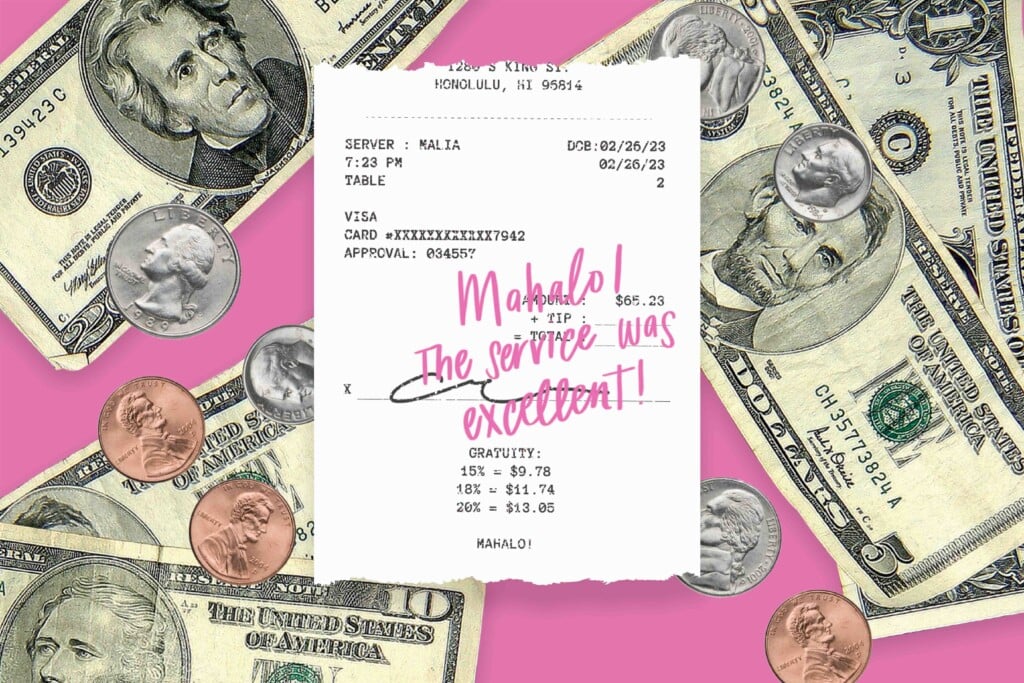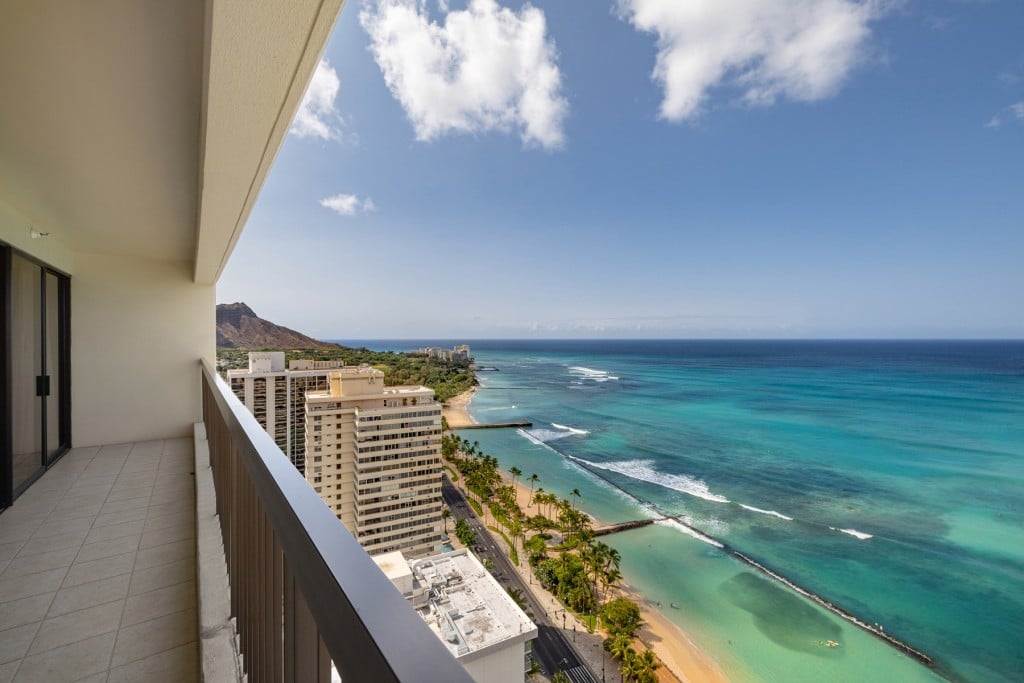The Transformed World of Tipping: What You Should Know
Digital payment systems, inflation and pandemic challenges can make tips more crucial for Hawai‘i workers – and more confusing for customers.

Talley aims to make at least $250 in tips each shift because that’s what she needs to pay her bills. Some nights she succeeds. Others, she’s way under.
Often, tips are based on factors outside of her control, like a customer’s mood upon arrival, the time it takes to get food and drinks out, the season, and who the customers are.
“Depending on where you’re at and how people are, sometimes you can get 10 percenters and you’ll be lucky if you make $200,” she says.
Talley has worked at RumFire for almost two years and enjoys her job. She and other service workers say that although tipping is unstable, it’s still a vital income source as inflation has pushed prices higher for food, gas, rent and other essentials.
Some local restaurants have changed how they request tips and added mandatory service fees to provide gratuities to back-of-house workers that customarily do not receive tips, like cooks, expeditors and dishwashers.
Lee Anne Wong, executive chef of Koko Head Café in Kaimukī and Papa‘āina on Maui, says many restaurants are still recovering from pandemic closures, staff shortages and rising costs from locally grown food, takeout containers and the need to pay competitive wages. She thinks diners need to be re-educated on what it means to eat out and why they should tip.
“Tipping is like literally taking care of the people who are taking care of you,” she says. “Consider the cost of your menu item. That’s the chair rental, that’s … the invisible people in the kitchen that are magically making the food for you – and they’ve been there all day. Understand the food you’re paying for pays all the bodies that you see.”
Tipping Habits
Tipping has increased nationally, driven partly by the adoption of digital payment systems that request gratuities. Some customers have been frustrated by the prompts, especially at places where tips normally aren’t expected, like at coffee shops and other counter-service venues. According to Fortune Magazine, tips at full-service restaurants grew by 25.3% in the third quarter of 2022 compared to the same time in 2021. Tips at quick-service restaurants increased 16.7%.
 Fortune’s data is based on information from Square, which operates digital payment systems for food and beverage, retail, beauty, and service businesses. Hawaii Business Magazine reached out to Square and was told the company could not provide state-level tipping data. The company did not respond to our request for updated national data.
Fortune’s data is based on information from Square, which operates digital payment systems for food and beverage, retail, beauty, and service businesses. Hawaii Business Magazine reached out to Square and was told the company could not provide state-level tipping data. The company did not respond to our request for updated national data.
Quarterly data published by Toast, a Square competitor that serves about 79,000 restaurant locations in the country, shows that about 48% of the transactions on its digital platform at quick-service restaurants included a tip in the fourth quarter of 2022. That’s 11% higher than the beginning of 2020.
It’s hard to say how much tipping has changed locally. Toast only provided Hawai‘i data for the last three quarters of 2022. That data shows Hawai‘i customers tipped an average of 18.8% in the second quarter and 18.7% in both the third and fourth quarters.
Restaurant workers say tipping is often hit or miss. Talley says RumFire, located in Kaua‘i’s Po‘ipū resort area, has higher prices and customers tend to leave higher tips compared with the restaurant she worked at before Covid. That restaurant was part of the Marriott Kaua‘i Beach Club.
RumFire typically sees more customers and tips in the summer, but tip amounts vary based on the individual or group. One customer might give 20% for good service while another might give 10%, Talley says. Sometimes, it depends on where the customer is visiting from. For example, tipping in Australia is considered optional and the standard tip there is 10%.
Tomoko Otani, a waitress at Mr. Ojisan Neo Bar and Sushi in Mō‘ili‘ili, says the restaurant’s regulars typically tip around 18% to 20%. New customers tend to leave 15%. Some don’t tip at all.
In some cases, there are fewer opportunities than before for customers to tip, such as when hotel guests check in without using bellmen and restaurant customers order food on their phones, says Eric Gill, financial secretary-treasurer for Unite Here Local 5. The union represents about 12,000 workers, including about 8,500 who work in hotels.
He says bellmen and valets rely on tips for much of their income, but some hotels were slow to bring them back and now have fewer bellmen and valet attendants working, so they sometimes have less time to talk with guests and receive tips. And while the union’s housekeepers don’t rely on tips to the same extent, they have fewer chances to receive them as hotels encourage credit card payments and guests carry less cash.
“We struggle with it because it’s people’s lives and incomes and families at stake and we do our best to try to keep the system as fair as we can,” Gill says. “That said, it’s just an imperfect system.”
Tip Requests
Kaua‘i musician Seth Womble collects tips by leaving an open ‘ukulele case when he performs on his own or with his band, the Napali Coasters. In his regular solo gigs at restaurants in Po‘ipū and ‘Ele‘ele, which tend to last at least two hours, he sees various tipping behaviors. Some diners want to be seen leaving tips, while others will send their kids up or slink by. Some who don’t tip avoid eye contact when they leave.
Womble, who often plays to a full restaurant, says people are probably being more careful with how they’re spending their money. In the last year, he started collecting tips through a Venmo QR code placed in his empty ‘ukulele case in addition to cash tips.
He provides the QR code as an option for listeners to show their appreciation, but only one or two people a night use it. Some listeners who do use it include short notes or song requests. Womble is a mural artist by day, and the tips help pay for his community projects.
Maria Rallojay worked as a waitress at a Filipino restaurant in Waipahu for four years until February. She says the restaurant charged parties of six or more a mandatory gratuity of 18% – a practice that began a few months after its dining room reopened in late 2020. Before that, the mandatory gratuity was 15% for parties of 10 or more.
Rallojay says mandatory gratuities make it easier for servers to get tips, especially on weekends when bigger groups are more frequent. Smaller groups, she says, tended to leave smaller tips, and some didn’t tip anything.
On a good night, she could make $300 in tips, which helped cover her UH tuition. Many co-workers would seek the busiest shifts to get more tips.
“I’m very grateful for people who do tip, but sometimes when they don’t, it feels like maybe I didn’t give them good service, or maybe it was just a really busy night and I didn’t cater to them as much,” she says. “But when I do get good tips, it’s really nice and after working a really long shift, it’s nice to just know I made something.”
‘Grateful for your Gratuity’
Papa‘āina is housed in the dark green, plantation-style Pioneer Inn just off Lahaina’s Front Street. In addition to serving brunch, dinner and happy hour in its open-air dining room, it operates a grab-and-go breakfast counter. Wong, the executive chef, says she put up a sign that reads, “Your gratuity is deeply appreciated by our counter staff who are working hard to serve you the fastest, freshest breakfast on Maui. Mahalo for your support!”
She says a lot of customers don’t tip at the counter and some question why they must tip for coffee. They don’t fully realize staff come in before 4 a.m. to open the counter at 6 a.m. and that a lot of work goes into making the food and drinks and cleaning up after people.
“I’m very grateful for tourism but I also want an educated tourist who understands what our community has been through and why things cost what they do and why they should tip their server or counter person or barista,” she says. “It’s like we’re barely getting by. People cannot afford to live in Maui. Period.”
She plans to increase her menu prices. A pound of locally grown cauliflower cost $6 before the pandemic; today, it’s $8. She says she could get cauliflower from the mainland for $3 a pound, but she’d rather support local communities. And if she were to use fresh orange juice, she’d have to charge $15 for an 8-ounce glass because her organic oranges cost $4 a pound and she pays the person who would make it $20 an hour. All her back-of-house staff make around $20 an hour.
Papa‘āina earlier in the pandemic added a 5% service charge on all checks so that its back-of-house staff, who traditionally don’t receive tips, can get an extra $5 to $7 per hour. Customers could choose not to pay it, she says, but the restaurant could also choose not to serve those customers if they return.
“For every person that says, ‘Why should we tip? Why can’t the restaurant pay more?’ Well, who’s paying for that?” asks Wong. “I’d be happy to raise my prices to where you think it’s unreasonable but that’s what it would actually cost if we were to pay our servers $40 to $50 an hour and our back of house $40 to $50 an hour because that’s what the back of the house deserves to make. But the business doesn’t support that.”
Wong says she’s exhausted from having to explain to the public why it’s important they tip their servers. The local industry could easily disappear, she says, because restaurants are constantly in tenuous positions with small margins and labor shortages.
She adds that her restaurants don’t take a tip credit. By law, Hawai‘i restaurants can pay tipped employees $11 per hour instead of the $12 minimum wage if those employees make at least $19 an hour in combined wages and tips.
Highway Inn’s Kaka‘ako location has had a 5% “mahalo kitchen charge” for the last seven years. Owner Monica Toguchi Ryan and CFO Russell Ryan wrote in an email that this is factored into the restaurant’s “suggested tip percentage” for its servers. They say they’ve had few complaints about this practice and sometimes hear from customers who say they should raise their menu prices instead. Prices are already up 10% to 15% compared to before the pandemic.
“We’ve had a lot of opportunity to think about this situation and still believe that our mahalo kitchen charge puts less pressure on our guests’ wallets when compared to forcing them to pay a higher menu price, which comes with a higher G.E. tax and inevitably a higher gratuity amount,” they wrote. Dine-in customers tend to leave a 12-18% tip in addition to the mahalo kitchen charge, they add.
Koko Head Café and Papa‘āina are among the many Hawai‘i restaurants that need more cooks, so they haven’t been able to return to pre-pandemic operating hours, Wong says. In January 2023, there were 66,800 people working at local food service and drinking businesses, according to the state Department of Labor and Industrial Relations. That’s almost 10% fewer workers than in January 2020.
Measuring Guest Experience
When Japanese American fusion restaurant Nami Kaze opened at Honolulu Harbor’s Pier 38 in 2022, chef/owner Jason Peel and GM Brandon Nakachi knew that finding workers would be a challenge, so they eased the workload by having customers order and pay through a QR code system.
They say it’s a casual way of ordering and takes some of the work off their servers, enabling them to instead spend more time talking with guests and ensuring they feel like family.
Nakachi says the system has improved efficiency and created the positive restaurant experience they envisioned. The average tip is 20%.
“It’s a good measuring stick for how the guest experience is,” he says. “If I see that, then I see a majority of guests are happy and that means hopefully they’ll come back and spread the word about us.”
Beau Hannafious and Jo Weaver-Hannafious, owners of Rainbeau Jo’s coffee shop in downtown Līhu‘e, say tips are a testament to the service provided by their employees.
Those tips also help their employees better afford to live on the island, they say. Most already have second jobs. Prior to opening their shop at the end of 2022, they operated a coffee truck. They say tips, especially from loyal local customers, helped them survive.
Monica Toguchi Ryan and Russell Ryan wrote in an email that it’s a win-win when guests are happy and staff are rewarded through tips.
“Good tips also help with server retention; if our servers feel that customers appreciate and recognize them for what they do, they will want to stay,” they wrote.
Here’s How Much Hawai‘i Customers Tip
Here are the average tip percentages for full-service restaurants and quick-service restaurants, according to Toast.

Toast, a company that operates digital payment systems for restaurants, ranks states based on their average tipping percentages. Hawai‘i ranked 46th in each of the last two quarters of 2022 with a total average tip of 18.7%. In the fourth quarter of 2022, 41 states had average tip percentages of 19% or higher, with Delaware, the No. 1 state, at 21.8%. California ranked 50th with an average tip of 17.5%.
Tip Credit
Earlier this year, the legislature considered a bill to increase Hawai‘i’s tip credit to 20% of the minimum wage. Several restaurants, plus the Chamber of Commerce Hawaii and the Hawai‘i Restaurant Association, supported the bill, saying the tip credit keeps overhead costs down and helps to balance wages between tipped and non-tipped staff.
Highway Inn testified that its highest paid hourly staff members in 2022 were the minimum wage front-of-house workers, who took home $80,594 in combined wages and tips. On the other hand, a person who was paid $18 an hour had a gross salary of $40,829 without tips.
“Legislators need to separate highly tipped professions, such as servers, who make close to $100,000 a year while making minimum wage, from the same legislation aimed at workers making only minimum wage and around $20,000 a year,” Toguchi Ryan and Ryan wrote in an email to Hawaii Business, adding that the mechanism for that is the tip credit.
The bill ultimately died after receiving overwhelming opposition. One of its strongest opponents was the Hawai‘i Workers Center, which was established in 2020 to train and organize workers. Sergio Alcubilla, its co-executive director, says even though Hawai‘i’s tip credit is only $1 an hour, the lowest among states that have tip credits, it still comes out to $2,000 a year that the employee could be using to help offset the state’s high cost of living.
“I think there’s a narrative in the community that people are saying, ‘oh, these tipped workers are already making $11 an hour plus tips,’ but at the end of the day, not everyone works at a high-end restaurant or not everyone works at a fancy restaurant,” he says. “So that’s one narrative that we’re trying to combat, like not everyone is doing well. And there’s nothing wrong with a server or waiter making good money.”
The center advocated for bills that would eliminate the tip credit as part of the national One Fair Wage campaign. Seventy percent of the nation’s 5 million tipped workers are women and 43% are people of color, according to One Fair Wage.
“Just this whole notion of an industry being able to take wages away from their employees and putting the onus on customers to pay wages, I just feel like there’s something wrong with that system,” he says.







